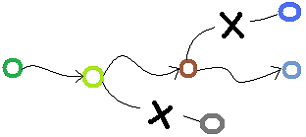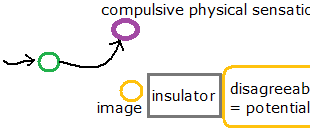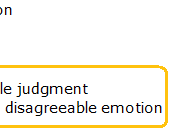The Kuriki method (the first edition in 2007) is a theory about Tourette’s syndrome (tic disorder) and obsessive-compulsive disorder to cure these diseases without medication. This theory is based on the author’s inference and interpretation regarding the structure of these diseases. Since it has been written for the psychoanalysts, reading will be difficult for people in general and it might be sometimes read erroneously. Therefore the Kuriki method must presuppose that the patient is treated by a nearby psychoanalyst, and that, between the patient and the Kuriki method, there is always the psychoanalyst. The explosion of emotional catharsis, which has strong repercussions, is done only for three seconds, once a week: beyond this rhythm, it would be an accident caused by negligence, and the psychoanalyst who is inexperienced in emotional catharsis must take responsibility for the temporary mental collapse caused by the accident. Also, to the patient who has weak capacity of logical reasoning, the psychoanalyst must explain well on the violent emotion of revenge caused by the illusory confusion between the person of the traumatic image in his head and the person in the real world.
Cure for Tourette’s syndrome (tic disorder) and OCD without medication
§24

Association
Dogs have a keen sense of smell: we, human beings, possess high performance capabilities too. Identification and memory of the sequences of syllables of words, melodies, faces of persons, etc. Associations of these objects are done unconsciously, and a similar word, a similar melody or a similar face often comes to mind. The objects pass from the Unconscious to the Conscious, and the associations follow one after another as a function of the brain. The association of an object called a single object. If an association called more than one object, it would become chaotic in mind. If a melody called several similar melodies at the same time, it would be devastating to listen to them all in your head. After several associations, there would be an exponential number of melodies in mind. Similarly, if several faces came to mind all at once, or if you did not stop punning from the same word, etc.
The mechanism of the association has a regularity. The association of an object called only one object. Once an association has been done, it is difficult to have another association at the same time from the same preceding object. (In a dream, an object can have some associations together.)
Judgment is an association, and two distinct judgments for one object cannot be done at the same time.
In addition, it is important that once an association has been done, the former association disappears. When we awake, we forget the dream. This can be done by the same mechanism: the previous association does not remain, so that thinking goes forward in a simple manner.
The method Kuriki considers that repression works with the same mechanism of association. The function of repression signifies these five types of restrictions of objects of the Conscious.
1. Inside the traumatic image:
Freezing of a disagreeable judgment. Blocking of an intuitively disagreeable judgment and the emotional expression of it is not done in the Conscious.
When a battery is part of the circuit, electrons move in a chemical reaction. As the battery is a combination of substances that makes electricity, there is no electricity in the battery, but also this potential state of energy can be imagined as if the battery were full of electricity. Behind the traumatic image, a disagreeable judgment has been frozen, and when catharsis has been “connected”, a disagreeable emotion will gush out. This can be said that, behind the traumatic image, there is a mass of emotion, which is full of disagreeable emotion. Potential emotion is a cold mass; a reversed existence, which can be represented by its dashed border, or by a black and white photographic negative, so to speak.
Freezing of a disagreeable judgment
= Potential disagreeable emotion
= Disagreeable emotion in the hermetic capsule of insulator
2. Outside the traumatic image:
Avoiding the traumatic image. As the disagreeable emotion is hermetically conserved, the traumatic image is always there among many ordinary images. The central traumatic image of the early childhood is often masked by some other images, which are obviously disagreeable. The Unconscious avoids that the traumatic image becomes an object of the Conscious. The traumatic image does not disappear, even after losing the associative connection. The traumatic image is always visible just like the spine cover of a book that you don’t read among many other books on the shelves. The central traumatic image of the early childhood may be identical to posterior traumatic images; in that case, the central traumatic image of the early childhood is characterized by the perfect absence of the disagreeable judgment.
3. Avoiding that libidinal bodily sensations (primitive bodily sensations)become objects of the Conscious: it means the genitals, the anus, the bladder, as libidinal bodily sensations in neurosis of small children of three years old.
4. Avoiding that disagreeable bodily sensations in general (indefinite bodily sensations) become objects of the Conscious. While the majority of tic patients think first that they do not have psychological trauma, after frequent awarenesses of indefinite repressed sensation for each « compulsive intramuscular sensation » of tic disorder, the direction of his or her psychological trauma will be automatically visible within two or three weeks. Often the « compulsive intramuscular sensation » of tic disorder moves temporarily (i.e., a new type of tic movement begins temporarily), or obsessive-compulsive disorder appears temporarily, but it is the process of healing of tic disorder. The awareness of indefinite repressed sensations, that is to think, for example, the chair is hard, if the chair is hard, or to think the legs are tired, if the legs are tired.
5. The Super-ego: avoiding libidinal manifestations in the Conscious, except for sexual desire. Here, these are manifestations in the Conscious, not in actes.
Association in Tourette’s syndrome
The repression is a function that prevents that disagreeable objects from being objects of the Conscious, but in order to avoid them, these objects must be seen. The solution to this paradox that to watch something in order not to watch this thing is that the Unconscious watchs the disagreeable object and makes the Conscious watch something else. Neurosis is a state where the Unconscious forces a deviation of the intentionality of the Conscious to any bodily target other than the object of repression. This bodily target is the symptom, which is the « compulsive intramuscular sensation » of tic disorder and tic movement. Syndrome of Gilles de la Tourette is a state where the « compulsive intramuscular sensation » of tic disorder and its bodily precise movement of tic are imperatively linked in Absolute-Compulsion.
When there is something you don’t want to see, you look at something else. Anything else can be a means not to see the thing you don’t want to see.
When a baby cries, you shake a doll so that the baby represses the trouble: it is the same mechanism as repression. As a therapy for tic disorder, in the Kuriki method, we consider that the Unconscious does the repression of an object by the association with another object by giving it a priority. In the lower layer, tic is a mechanism to divert the intentionality of the Conscious towards another object each time an association is approaching to the traumatic image: another object, that is the upper layer.
Behind the traumatic image, the disagreeable judgment has been repressed, and the traumatic image is classed as an ordinary image among other ordinary images. The Kuriki method uses the term “insulator” for “Affektisolierung” of the Freudian psychoanalysis. The insulator between the traumatic image and the potential emotion under this image. For example, if a very little girl has been touched every day by someone of the family and if she represses the disagreeable judgment, this image will be classified in the same way as ordinary happy images in the memory. Until she does some emotional catharsis, this psychological trauma will remain ignored. Small children have sensitivity and tendency of repression that are different from adults. To be more precise; while having the same sensitivity as adults, small children often do not know disagreeable judgments. In the bathroom, adults should not show the genital organs every evening to a small child. If, in the family, someone has undergone an amputation, small children should not watch every day the scar. If the disagreeable judgment to a disagreeable event that is repeated every day has not been expressed in the head, the image of this event will be classified as an ordinary image. Breastfeeding might be dirty thing. The traumatic emotion can be there, under a very obvious image. In a psychoanalysis, you must pay attention to the things that have not been associated, the things to the detriment of which another association has been done. You have to search in the opposite direction of associated things. Under a disagreeable image, there can be another disagreeable image.


